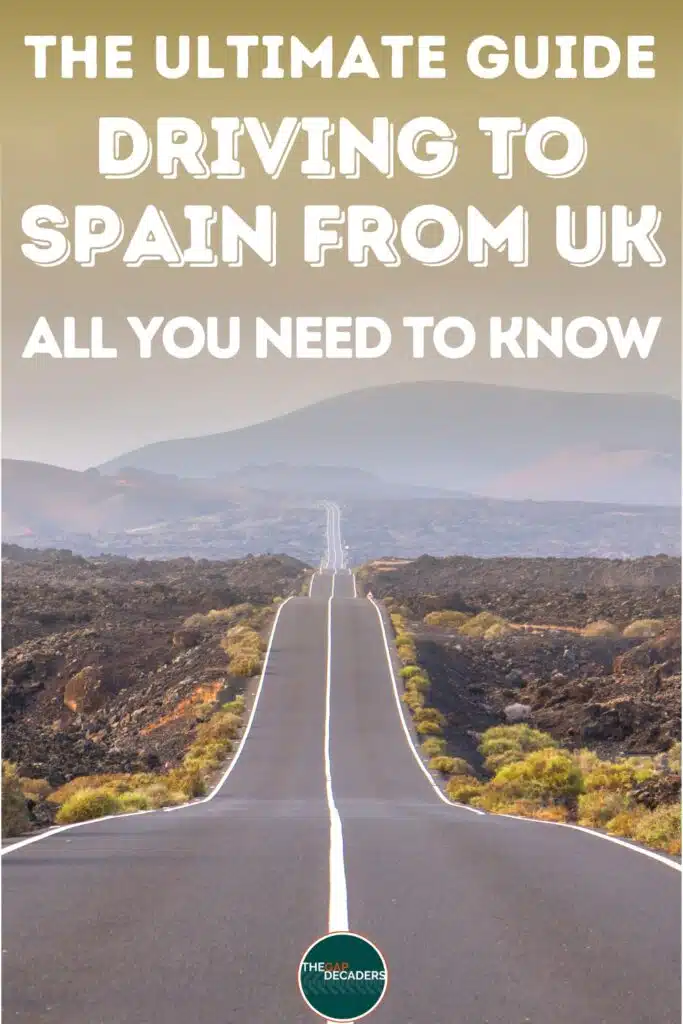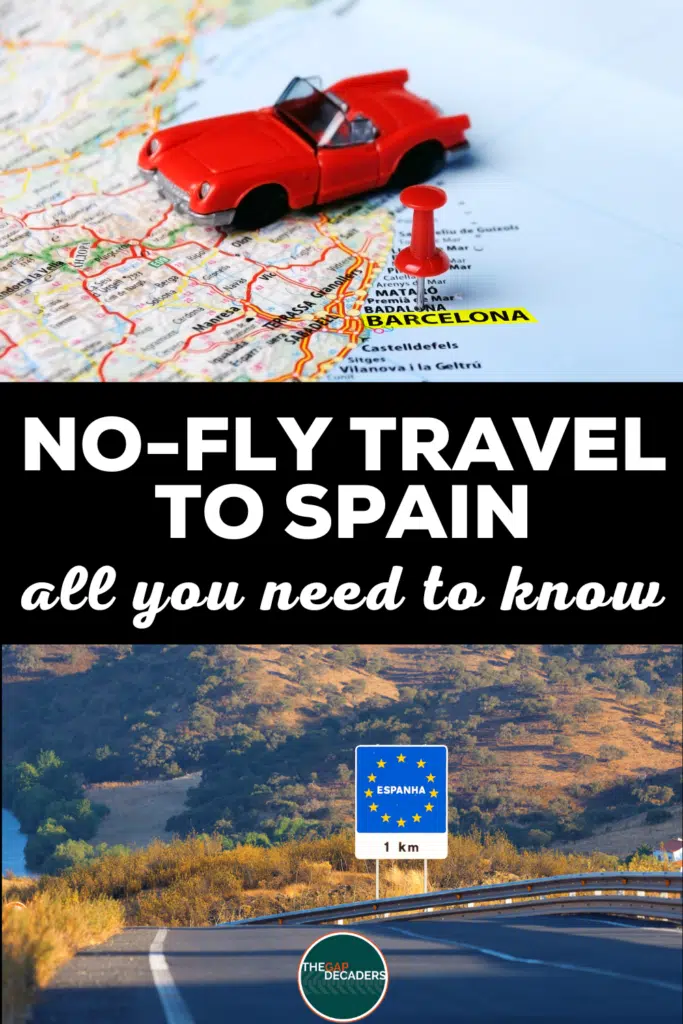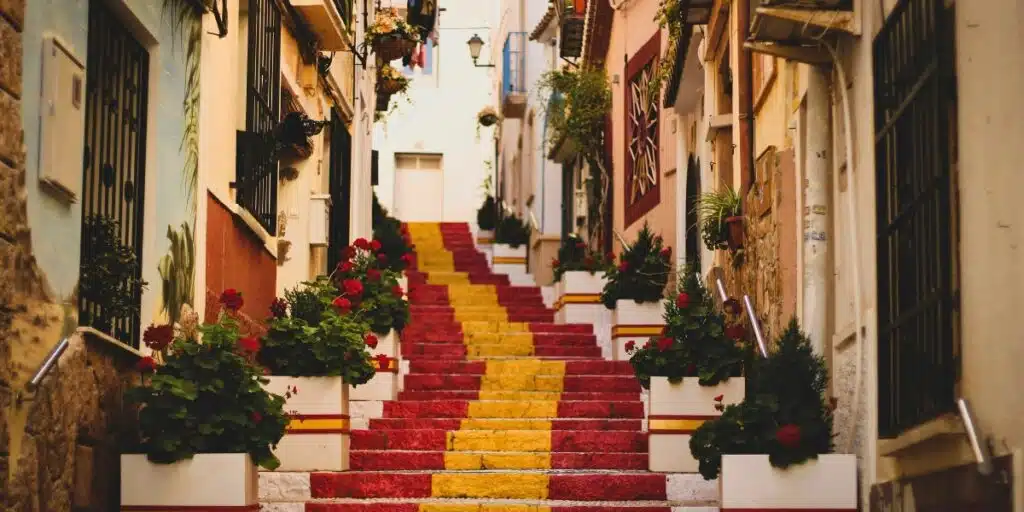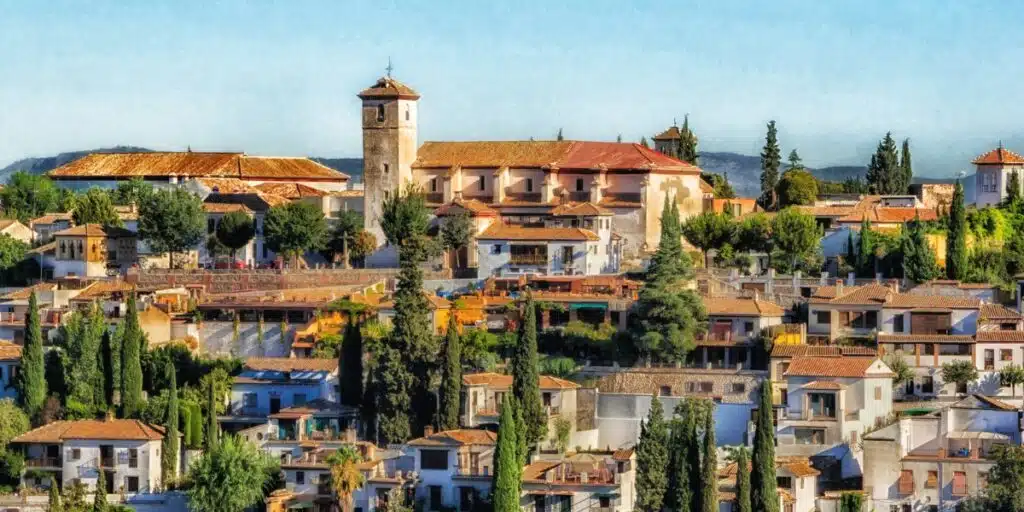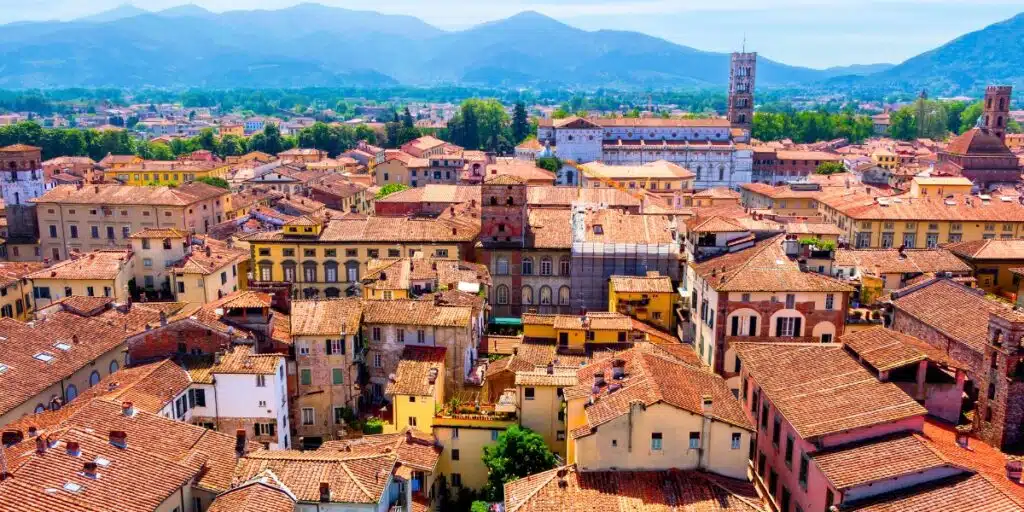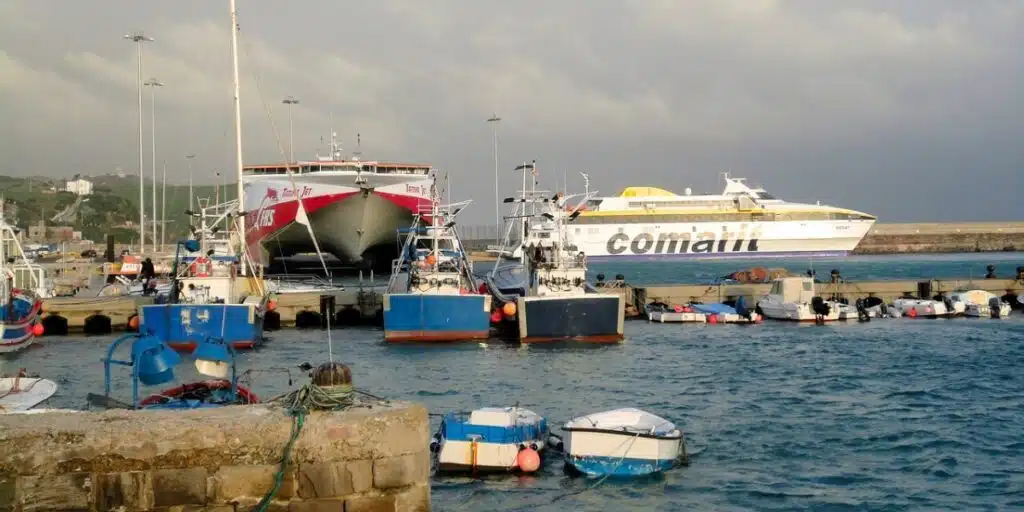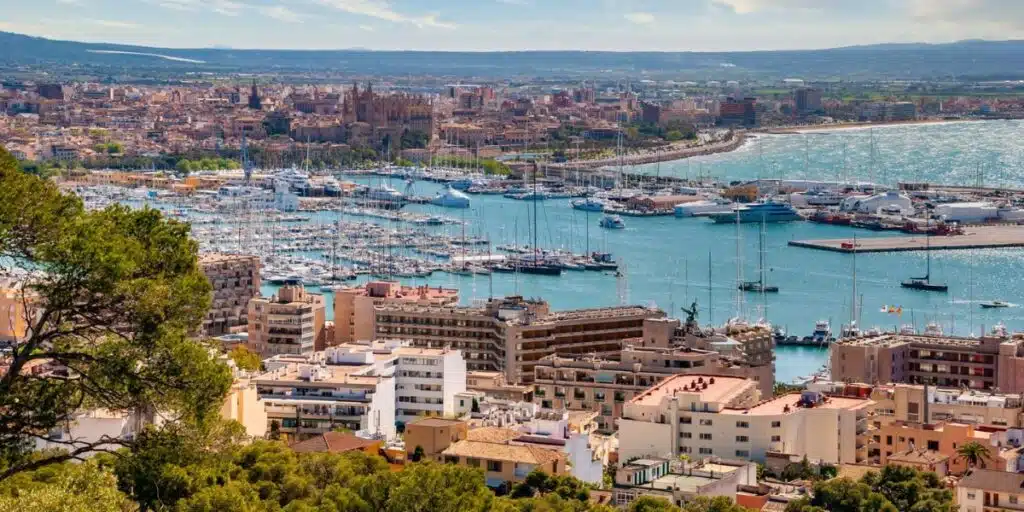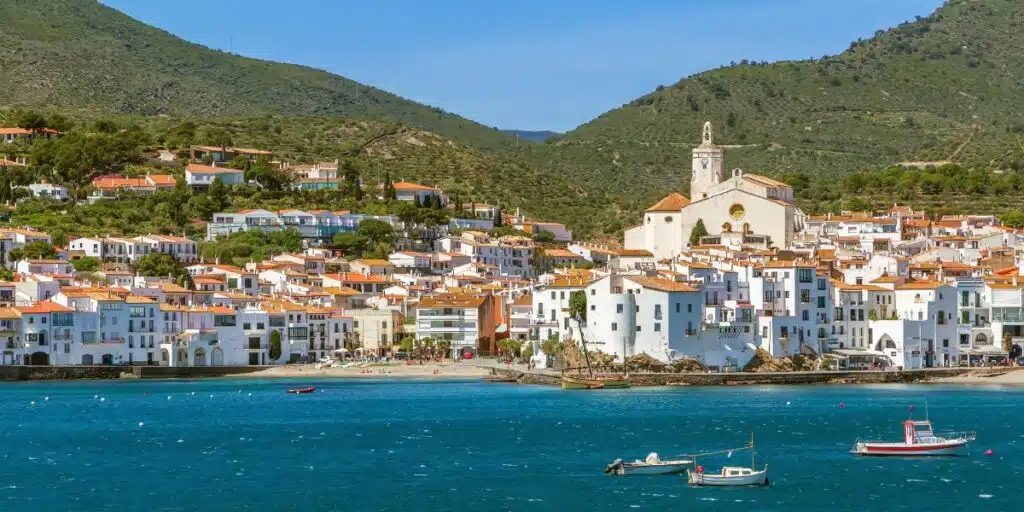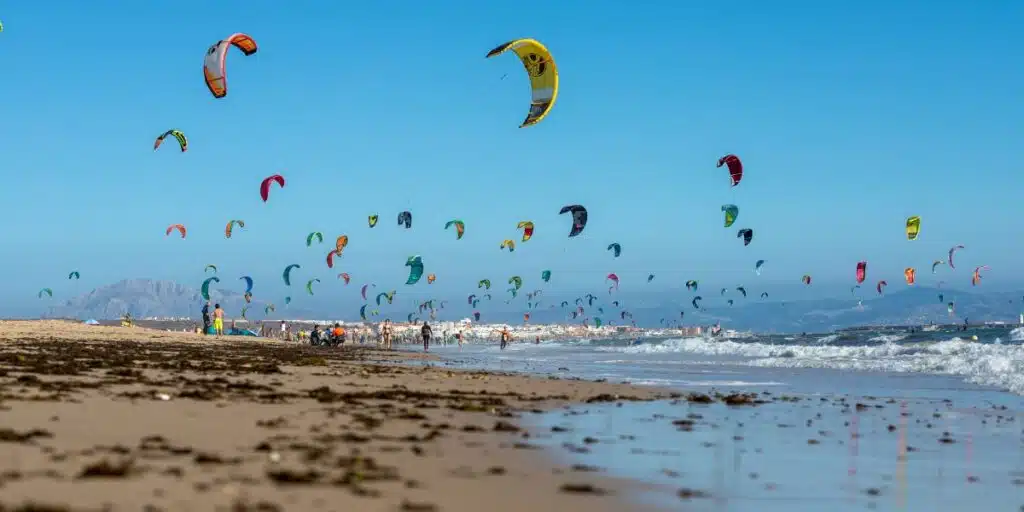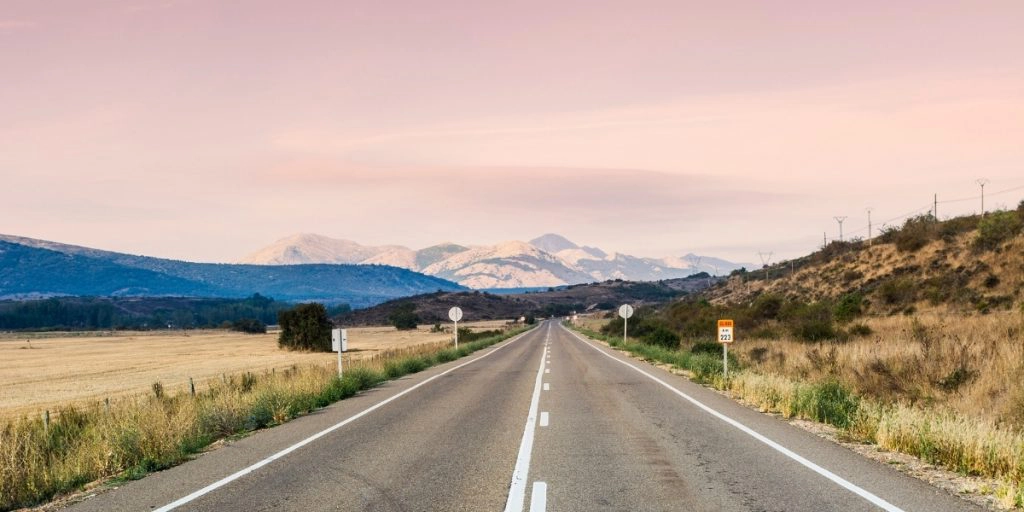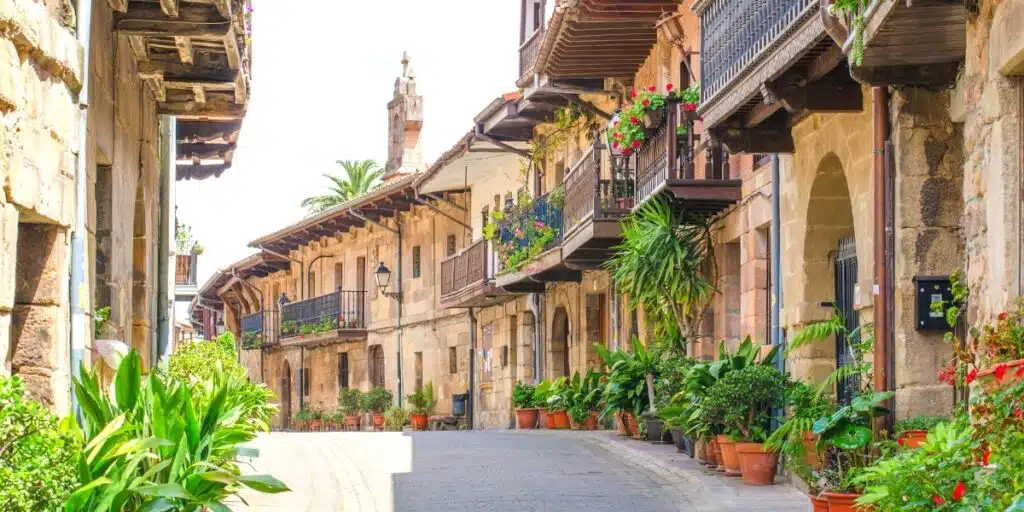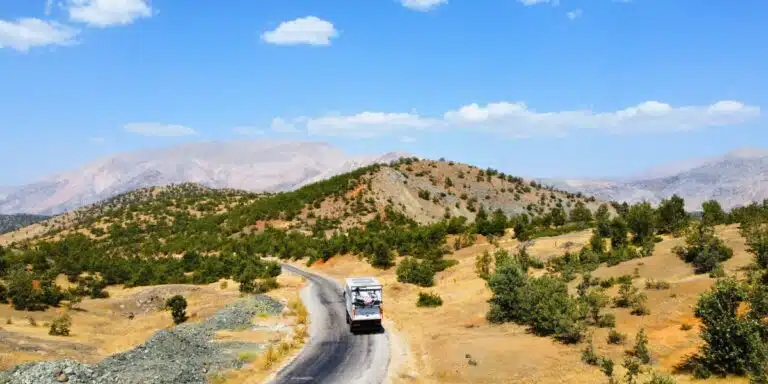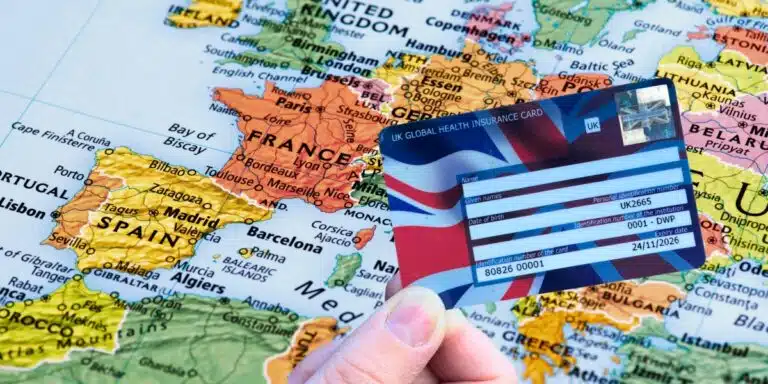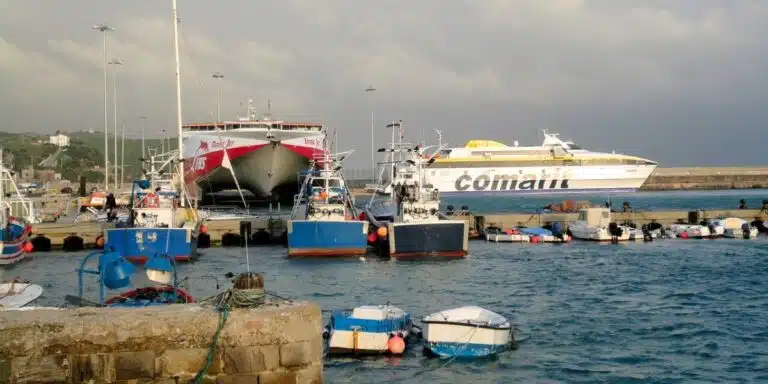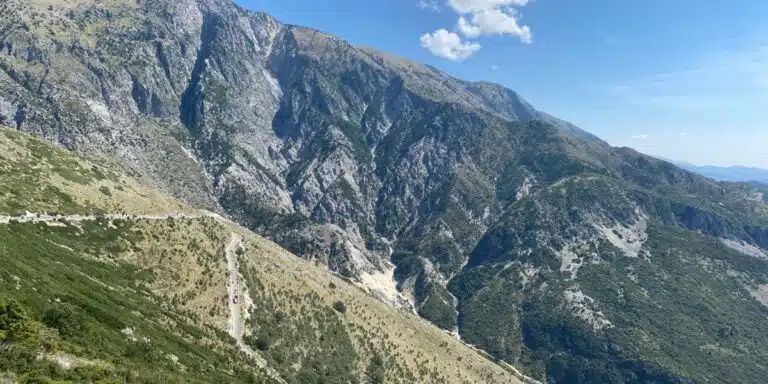This post may contain affiliate links, from which we earn an income. Click here to read our affiliate policy.
The best routes to Spain from the United Kingdom
Craving the warmth of the Spanish sun but not keen on hopping on a plane? Why not hit the road instead? With fantastic routes across Europe, driving to Spain from the UK is easier than you think, and you’ll arrive refreshed and unstressed from the comfort of your own vehicle.
As Brits travelling in Europe, we’ve driven to Spain countless times – by car, motorhome, and even motorbike. Now, we’re sharing our tried-and-tested routes, cost breakdowns, comparisons, and insider tips to make your adventure unforgettable.
Whether you’re planning your first drive or looking to perfect your journey, our comprehensive UK-to-Spain guide will help you pick the ideal route, so you can roll into Spain relaxed, ready, and raring to explore!
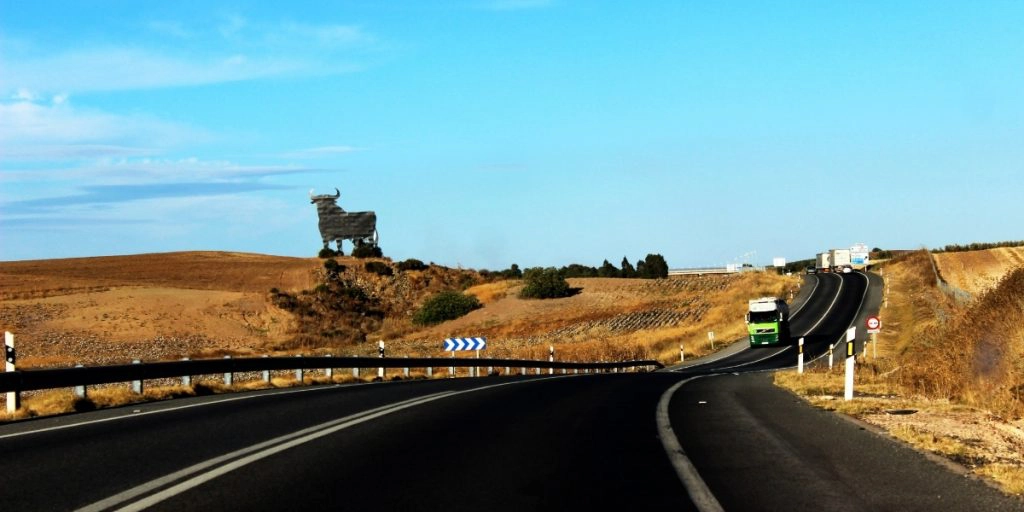
Summary of the Best Routes to Spain from UK
Getting to France
EuroTunnel Le Shuttle
The fastest English Channel crossing route is using the Eurotunnel Le Shuttle from Folkstone to Calais. The crossing under the channel takes 35 minutes, and with a slick check-in and loading/unloading process, you can be in France proper in an hour.
This crossing is ideal if you are driving to Spain from UK with a dog or just want to get to the other side as quickly as possible.
Dover to Calais Ferry
The quickest way by ferry is undoubtedly the Dover-Calais route, on which both P&O and DFDS operate up to 40 crossings between them a day in July and August. Taking just an hour and a half, you’ll have time on board for a meal or drink and perhaps a quick snooze.
Getting on and off can take a while, though, as they have to piece all the vehicles together like a jigsaw puzzle. It’s not as quick as the shuttle, but it’s very possibly a bit cheaper, especially if you can be flexible with crossing times.
Portsmouth to Caen / Cherbourg Ferry
More expensive and quite a bit longer than the Dover-Calais route, the Brittany Ferries crossings from Portsmouth may prove to be cost-effective in fuel and toll costs if you don’t live in the southeast of England.
The Caen route operates three crossings a day, one of them overnight, meaning you’ll arrive in France refreshed (but will have to book a cabin or reclining seat) and ready for a full day’s driving.
The Cherbourg route crosses at least 12 times a week and uses a fast catamaran service, taking just three hours from port to port.
Other Popular Crossings
There are a handful of other routes out of Newhaven, Folkestone and Poole which are also worth exploring. You could also consider sailing to Le Havre or St Malo from Portsmouth or Dunkirk from Dover.
The key here is to be flexible with dates and times to get the best deals…this is where you may just find a bargain.
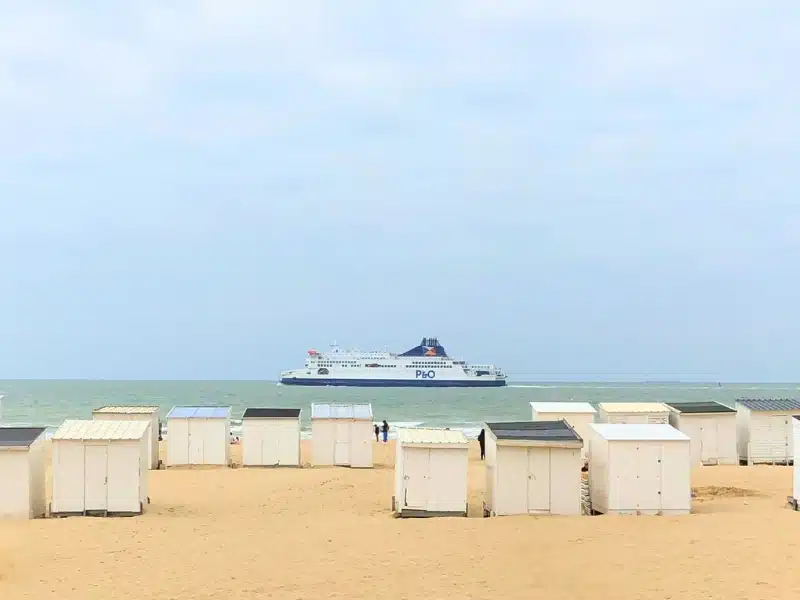
Is this your first time visiting France and Spain? Get all the information you need in our France Travel Guide and Spain Travel Guide including what to pack, the best time of year to go, getting there and practical tips to help you have the best trip!
The Best Routes Through France to Spain
UK To Spain Driving Routes Map
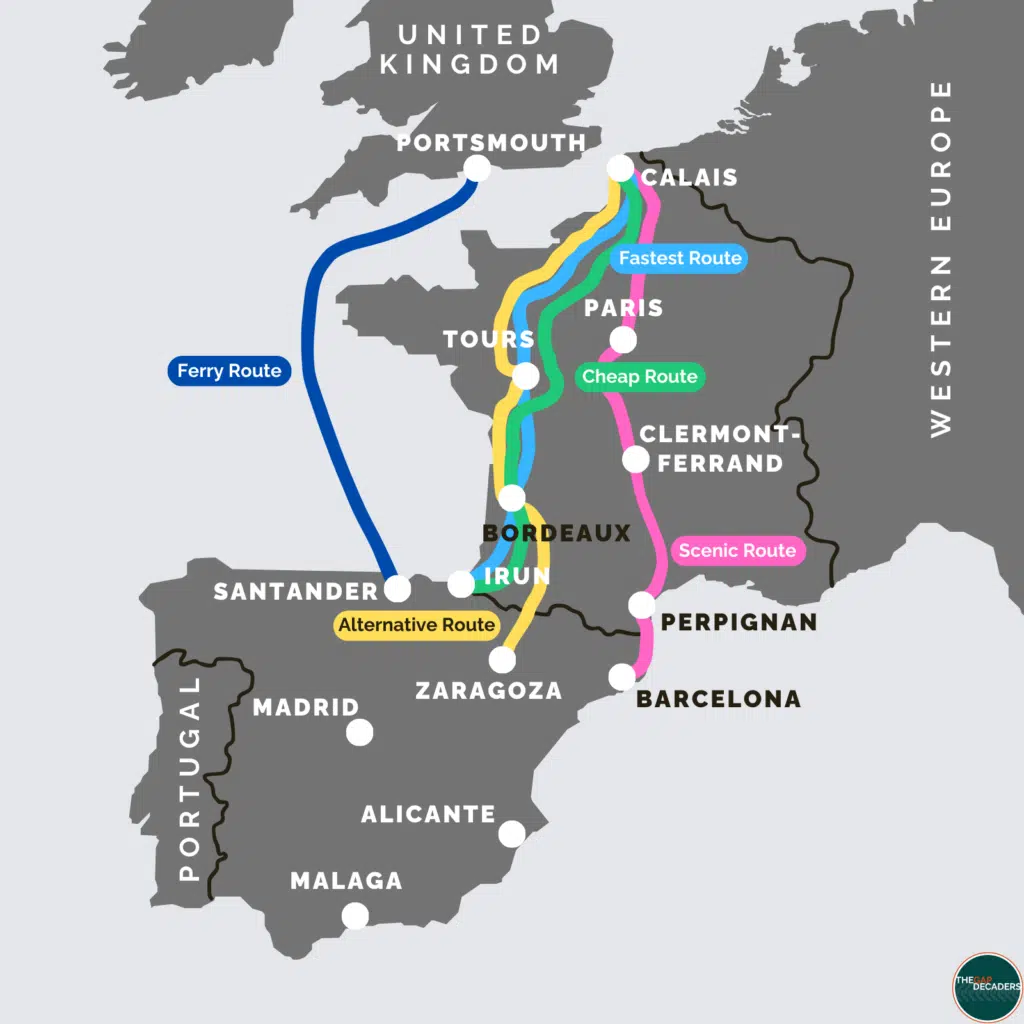
Quick Comparison of Routes to Spain
| Route | Drive km | Drive Time | Cost € |
|---|---|---|---|
| 1. Quickest Route | 1101 | 12 | 350 |
| 2. Most Scenic Route | 1376 | 15 | 226 |
| 3. Cheapest Route | 1096 | 16 | 116 |
| 4. Alternative Route | 1262 | 15 | 269 |
| 5. UK to Spain Ferry | 0 | 0 | 500+ |
1. The Quickest Route
Calais – Rouen – Le Mans – Tours – Poitiers – Bordeaux – Irun
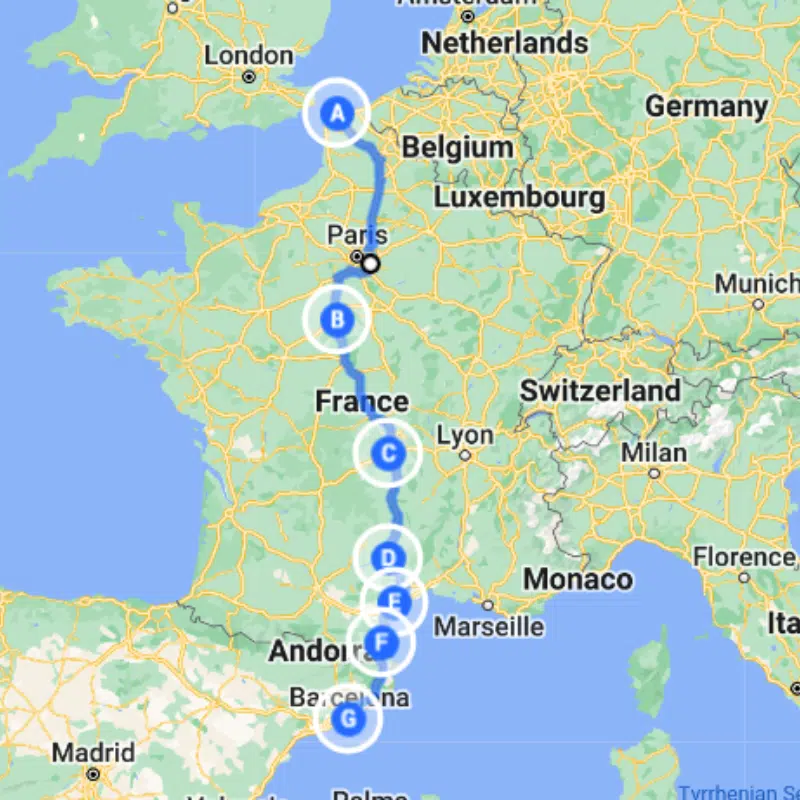
Whether you cross into Calais, Caen or Cherbourg, the quickest road to Spain is down the western side of the country via the A28 and A10. You’ll miss the significant high ground in the middle of France and be able to travel on autoroutes pretty much all the way.
From Calais, head for Rouen, then Le Mans, Tour, Bordeaux and down to the border at Irun. For those arriving in Caen or Cherbourg, head for Le Mans and pick up the remainder of the route there.
You could barrel all the way down to the Spanish border in a day if you were sharing the driving, but we would suggest an overnight stay in Tours if coming from Calais before a second stop in San Sebastian in Spain. If coming from Caen or Cherbourg, Bordeaux makes a perfect stopover. If coming from Caen or Cherbourg, Bordeaux makes a perfect stopover.
Be aware the whole of Rouen is covered by a low-emission zone meaning you will need a Crit’ Air sticker. There are also several low underpasses on the route, which will decapitate a motorhome or car with bikes on the roof. You can avoid these by taking the street-level side road next to them; just be aware!
2. The Most Scenic Route
Calais – Paris – Orleans – Clermont-Ferrand – Millau – Beziers – Perpignan – Barcelona
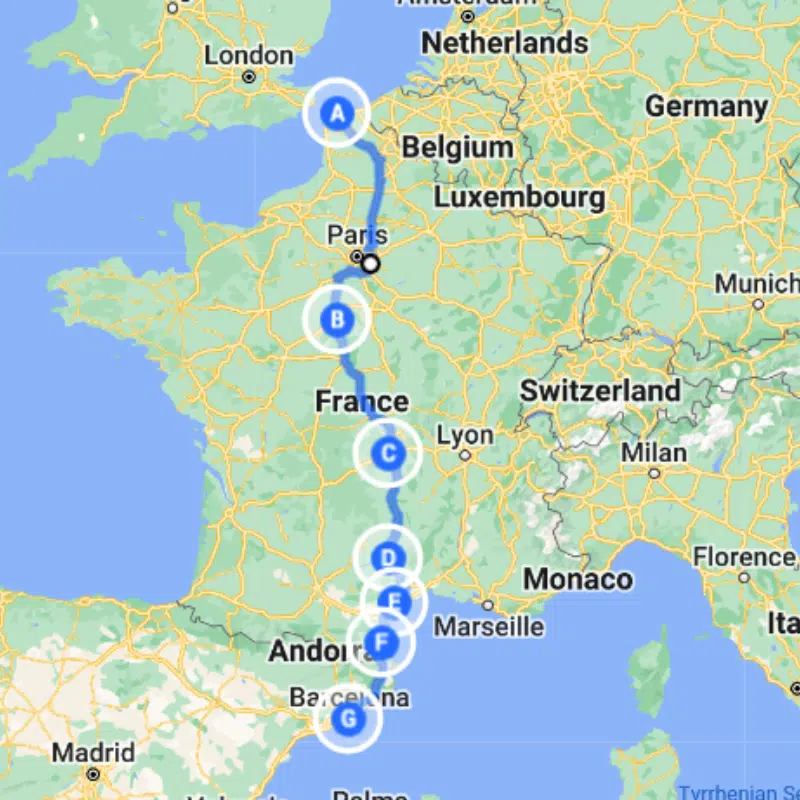
Driving from UK to Spain by car doesn’t have to be boring. This great route will take you through some of France’s most spectacular scenery and across the Massif Central via the A71 and A75 roads.
From all the ports, head for the Paris ring road and follow your sat nav judiciously… you really don’t want to end up in inner-city Paris! Perhaps stop off, find a good hotel and take in one of the most beautiful cities in the world before heading south.
Next up is Orleans on the banks of the Loire River and home to Joan of Arc. From here, head south Clermond-Ferrand, surrounded by dramatic extinct volcanoes and authentic French countryside villages, perfect for a few days of hiking before you hit the road again.
Make for Millau and cross the highest road bridge in the world en route, the incredible Millau Viaduct.
Your next stop is Beziers, home to the Canal Du Midi and its famous nine locks. This often-overlooked city makes a great pit stop.
Finally, you’ll reach pretty Perpignan, where you can enjoy the last of France before crossing the border into the north of Spain and driving to Barcelona, the perfect city in which to stop for a day.
You will be able to find great hotels in all these destinations, allowing you to enjoy a slower pace and see some off-the-beaten-track France.
Perhaps take the scenic route to Spain and take the fast route for the return journey, when you’ll be looking forward to getting home.
3. The Cheapest Route
Calais – Rouen – Chartres – Poitiers – Angouleme – Bordeaux – Irun
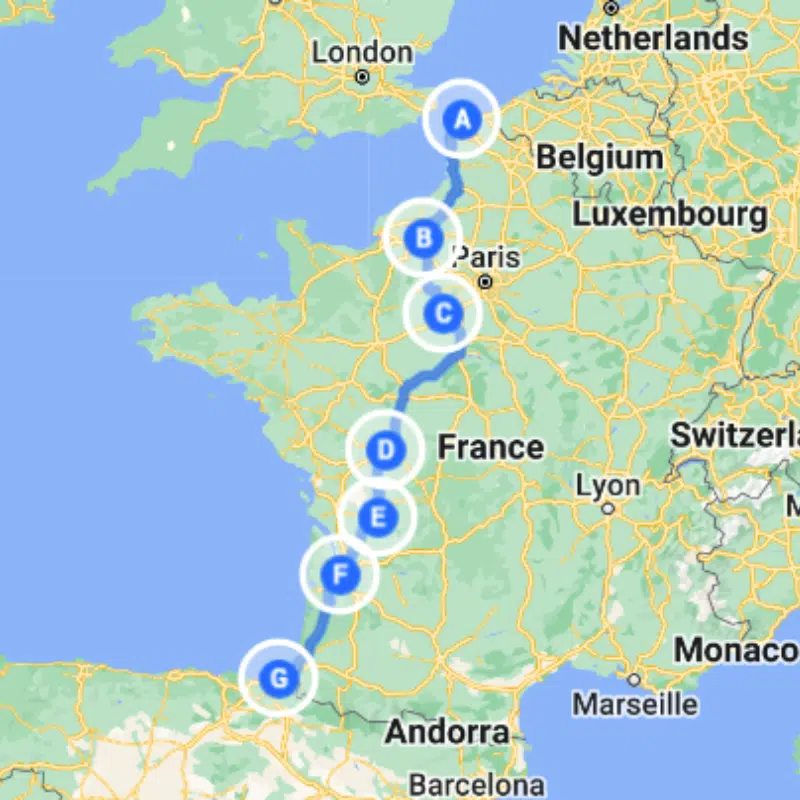
Driving to Spain from UK and avoiding tolls is very possible. You will still travel down the western side of the country, with the route relying heavily on the A28, N10 and A63 toll-free roads. Make sure to set your sat nav to avoid tolls.
Although this is a good route for those travelling on a budget, not all stretches are dual carriageways, and you risk slow-moving vehicles and traffic jams, especially on the approach to larger cities. This choice of route is likely to take longer than the stated 15 hours.
Be aware the whole of Rouen is covered by a low-emission zone meaning you will need a Crit’ Air sticker. There are also several low underpasses on the route, which will decapitate a motorhome or car with bikes on the roof. You can avoid these by taking the street-level side road next to them; just be aware!
4. The Alternative Route
Calais – Rouen – Le Mans – Tours – Bordeaux – Somport Tunnel – Zaragoza
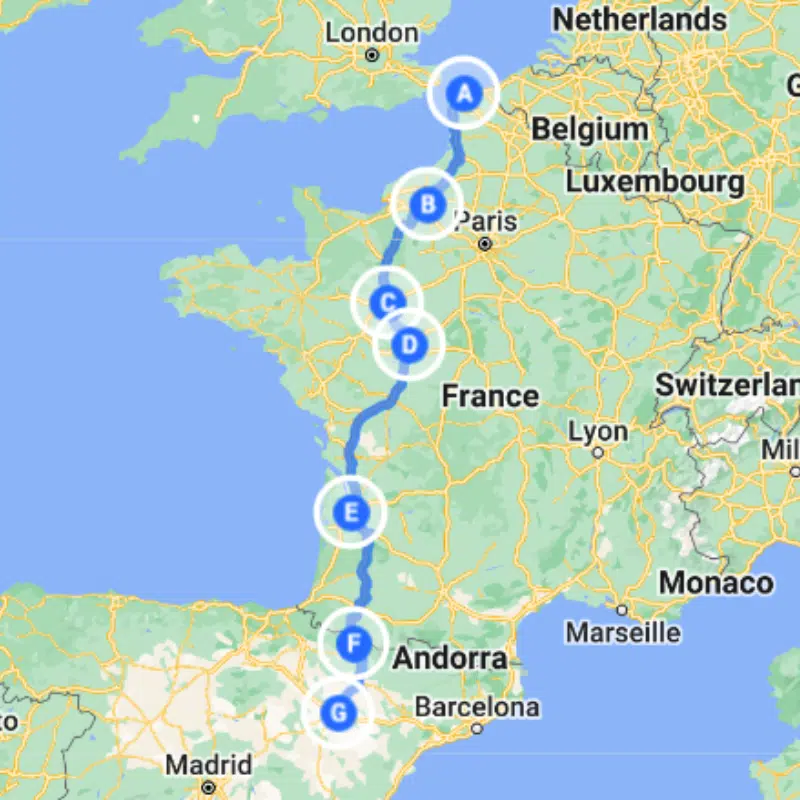
Using the fast A28, N10 routes south before veering east at Bayonne for the Túnel de Somport cuts out the border at Irun and the long drive down to Zaragoza. This alternative route works well if you’re heading for Spain’s east coast, the capital city of Madrid or the south of Spain.
Unbelievably, the 5.3km of the Somport Tunnel is toll-free, although this route can be affected by bad weather in winter and carrying snow chains is a must.
5. England to Spain Ferry
Portsmouth or Plymouth – Santander or Bilbao
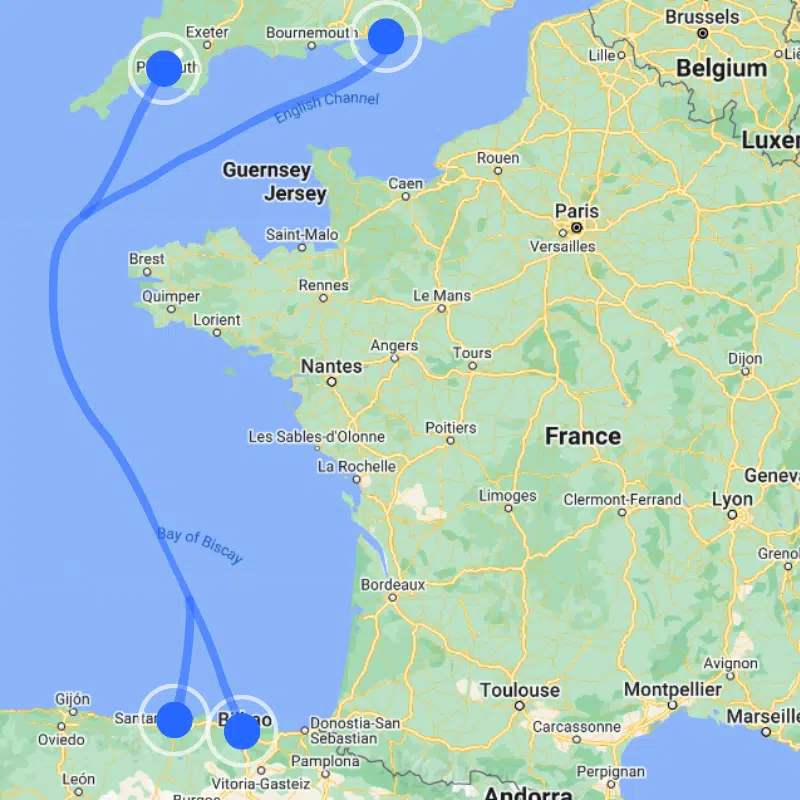
One of the simplest ways of getting to Spain is to miss France altogether and get a ferry crossing to Spain from UK, sailing from Portsmouth or Plymouth to Santander or Bilbao in northern Spain.
The catch is that the UK to Spain ferry crossings take a long 33 hours, and you’ll need to spend a night (or two in winter) onboard. The boat gets booked up quickly and can be expensive, even taking into account the costs of tolls and fuel prices in France.
The long journey is also notoriously rough in the winter months, so you may want to find ways of avoiding seasickness if you choose this route!
However, if you don’t enjoy driving in Europe, have a pet with you or just want to take things a little more slowly, then taking a boat from UK to Spain may well be the best option. We often choose this route if we’re in our overland truck because the tolls in France are so punishing, and the ferry usually works out cheaper.
Looking for the best SIM card deals in Europe for your trip? Check out our guide to the best data SIMs in Europe and get the best deal for your trip to France and Spain.
Travelling in Europe
Thankfully, there are some common laws and regulations across most European countries for visitors from the UK and elsewhere.
Required Documents for EU Travel
Passport: You must have at least three months remaining on your passport (issued in the past ten years) at your intended date of departure.
Vehicle Insurance: You must have at least 3rd party insurance for your vehicle. You do not require a green card to prove you have vehicle insurance cover when travelling in Europe if your car is registered in the EU or UK.
Licence: You must have a valid driving licence. This allows you to drive in all EU countries for up to six months. If you only have a UK paper driving licence or a licence issued in Gibraltar, Guernsey, Jersey or the Isle of Man, then you will need an International Driving Permit.
Registration Document: You must carry the original registration document for your vehicle. In the UK, this is the V5C or logbook.
GHIC: Whilst it is not mandatory, we strongly recommend carrying a GHIC card, which covers you for emergency and necessary healthcare in the EU. Find out why the GHIC is an essential for touring in Europe!
Travel Insurance: The UK GHIC is not a replacement for travel insurance and will not cover things like repatriation, medical evacuation, specialist treatment or ongoing care. We recommend True Traveller for their 5-star TrustPilot reviews, variety of cover options, best activities cover as standard, great prices, and excellent service.
Breakdown Cover: Although not mandatory, it’s a good idea to have cover when driving in Europe. We recommend RAC Arrival, whose motorhome cover has no weight, height or length restriction. We have only needed their support once (in Greece with a blowout) and they were excellent.
EES and ETIAS: From an, as yet, unknown date in 2025, the EU will introduce the EES (European Entry/Exit System), to register non-EU nationals travelling for a short stay and ETIAS (European Travel Information and Authorisation System), which will be an additional entry requirement for visa-exempt travellers and will involve the traveller registering their details online before travelling, mainly for security purposes.
Vehicle Safety Requirements in the EU
Country Sticker: You must display a country sticker on the rear of your vehicle unless your numberplate displays the flag or origin. For UK-registered vehicles, this needs to be a UK sticker instead of the old-style GB sticker.
Headlights: Headlight beam converters must be in use unless you can adjust your headlights automatically.
Seat Belts: Seat belts must be worn by the driver and all passengers in all the countries of the EU.
Using Mobile Phones: It is illegal in all countries of the EU to use a mobile phone when driving. In addition, in France, you are not even allowed to use a mobile phone using a hands-free device, which you are permitted to do in Spain and the UK. On the spot fines are applicable in all countries if you are caught using a phone at the wheel.
Drive on the Right Side: Every EU country apart from Ireland drives on the right-hand side of the road. This means that when you’re at a junction or roundabout, the vehicle approaching from the right has priority over the one coming from the left unless other signage is in place.
In an Accident: If you have an accident you’ll need to complete the EU Accident Statement, which you can find to download in English in our free resource library if your insurer hasn’t provided one. Stop safely and use your hazard lights and warning triangle to alert other drivers. Exchange details (a translate app comes in handy here) and take plenty of photos to add to your form when you submit it to the insurers. If the other party won’t give details or there has been an injury, you should call the police on 112.
Things to Know Before Travelling in the EU
EU Borders
Both France and Spain are members of the Schengen Area, meaning borders between both countries are open. However, you may find that random roadside checks are in place at border crossings due to the number of undocumented migrants travelling through Europe. Make sure to have your passports to hand when approaching country borders.
Visas for France and Spain
You do not need a visa to enter France and Spain. However, at some point in 2025, the EU will introduce the ETIAS (European Travel Information and Authorisation System), which will be an additional entry requirement for visa-exempt travellers (including Brits) and will involve the traveller registering their details online before travelling, mainly for security purposes.
Length of Stay in EU
You may spend a maximum of 90 days in a rolling 180-day period in the EU.
The 90 in 180-day rule works on a rolling basis, and it can be difficult to work out whether you are within the rules or not, especially if you have visited the Schengen area on several occasions in the preceding 180 days. Use a Schengen calculator to ensure that you stick to the right number of days and stay within the rules.
Taking Food to the EU
The European Commission says the following:
Mobile Data in the EU
All UK providers limit data usage in the EU in some way or another. It’s best to check with your provider what their fair usage policy says before travelling, to make sure you don’t run up a big bill.
You can find lots of information in our guide to the best SIM cards in Europe, especially if you’re planning to be away for more than a few weeks.
Taking Pets to the EU
You can take dogs and cats and ferrets to France and Spain. You’ll need to book a pet-friendly cabin or kennels on the ferry or travel via the tunnel. Your pet will need a microchip, a valid rabies vaccination and an animal health certificate (AHC).
It can take some time to get all the documents together and the vaccines organised, so make sure you start the process well in advance. You can find out more about travelling with pets on the Gov.UK website.
Driving in France
Driving from UK to France and through the country is easy, with well-maintained roads and generally considerate and well-mannered drivers.
On the downside, there are regular disruptions and fuel blockades due to political tensions, so make sure you check the current situation when you leave home.
Follow these tips for a safe and easy transit through France on your road trip to Spain from England:
Mountain Law in France
On 1 November 2021, the Loi Montage II or ‘mountain law II’ came into force in 48 French mountainous departments within the Alpes, Massif Central, Jura, Pyrenees, and Vosges regions.
Anyone travelling in a vehicle through one of these areas between 1 November and 31 March will be obliged to fit four approved winter tyres or carry at least two snow chains or socks in the vehicle. You can find out more about France’s mountain law here.
Motorway Breakdowns in France
French motorways are privately managed and you’re not allowed to request your own assistance company to attend to you if you break down.
If you do break down, you should use the orange emergency telephones that are situated every 2km along French motorways to call the police or the official breakdown service operating in that area. Alternatively, if no orange phone is available, you should call the emergency services by dialling 112.
You will be towed to a safe, designated area where you can make onward arrangements for your own breakdown insurer to assist if you have it. Otherwise, the towing company will be able to provide support or signpost you.
Charges for assistance on a motorway are fixed by the government and are reviewed and revised each year. Many of the government-appointed towing services allow large insurers to pay them directly, but this is at their discretion and will depend on who your European breakdown cover is with.
If this is not the case, you should pay directly and then seek recompense from your insurer.
Motorway Tolls in France
Driving through France can be hideously expensive if you only use toll roads, but they do allow you to travel through the country to your destination quickly.
You may want to consider carrying an electronic toll tag, like EMovis or Bip&Drive (both of which cover you in Spain and Portugal as well as France), that deducts the fees from a credit card automatically, meaning you don’t have to stop at a booth or barrier.
Crit’Air Vignettes
France has introduced ‘clean air’ windscreen stickers as a legal requirement in many of its cities, towns and their peripheries, to identify a vehicle’s emissions levels and to restrict access in order to improve air quality.
This six-category sticker system is designed to identify what emissions vehicles produce and are categorised based on your vehicle’s Euro emissions standard. These are known as Crit’Air stickers, and you may need one for your vehicle, depending on where you visit or stop as you transit through.
If you intend to travel close to a city or use its ring road, it’s worth getting the sticker, which costs €3.81 from the official website. Find out more and purchase Crit’Air stickers from the official certificat-air.gouv.fr website.
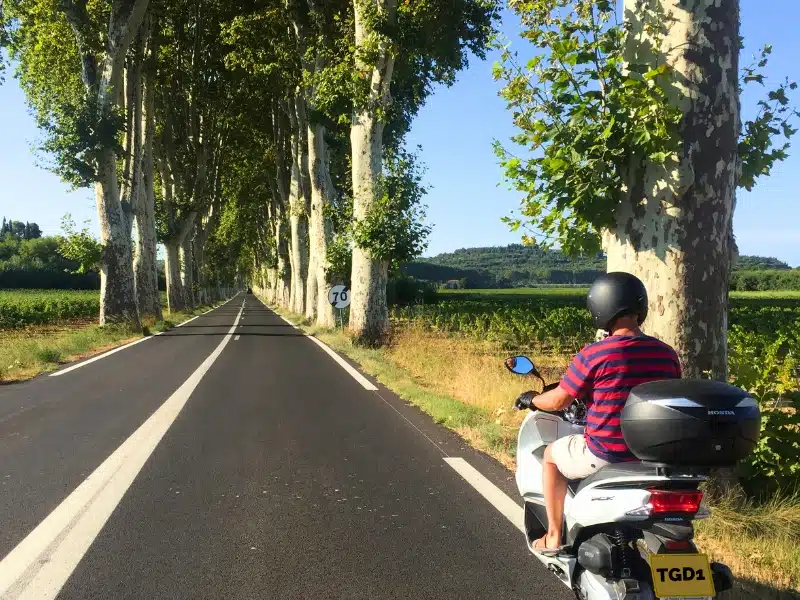
Don’t forget your road trip essentials! Our free road trip checklists help you remember everything, including road trip snacks, podcasts, and road trip songs for the journey!
Driving in Spain
Follow our guide for safe driving in Spain and enjoy your holiday!
Toll Roads in Spain
Toll roads are pay-as-you-go and are very reasonably priced, with some charges being abolished by the Spanish Government completely. These free motorways cover the eastern route south from Perpignan as far as Alicante. You can pay with cash or a credit card or use an electronic toll tag like Emovis or Bip&Drive.
Due to the huge swathes of nothingness in the interior, the toll roads are definitely worth taking if you are trekking from one side of Spain to the other. The AP7 on the Costa Blanca and Costa del Sol retains some charges, but they are minimal.
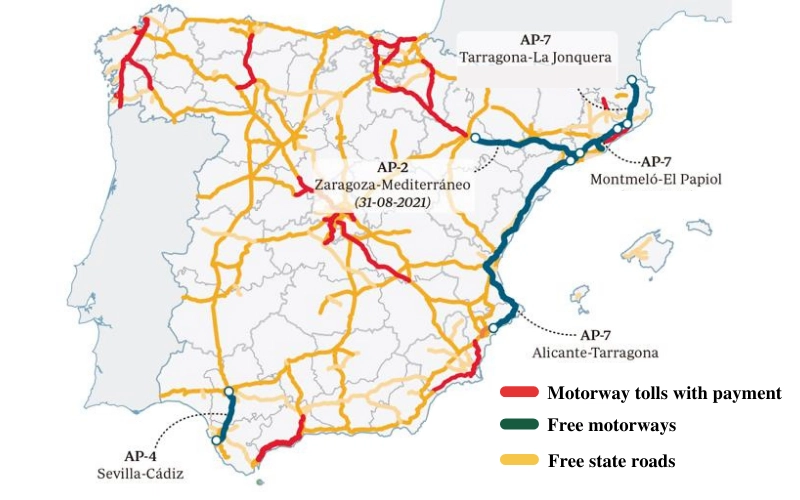
Low Emission Zones in Spain
At the start of 2025, there were 59 low emission zones in Spain and municipalities with more than 50,000 inhabitants required y law to have a low emissions scheme in place.
Vehicles, including foreign vehicles, are not required to buy or display a sticker, although they do have to meet the required standards.
If you are stopped, you may be able to do this with your V5C, Certificate of Conformity or LEZ sticker from another country. The only exception is in Barcelona, where you will need to register your vehicle in order to drive within the LEZ here.
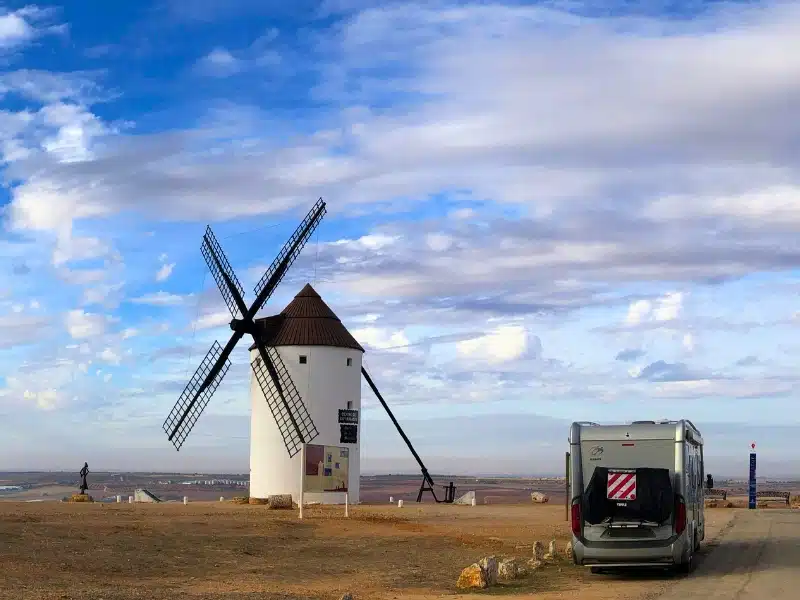
Onward Travel in Spain
You’ve arrived! Spanish motorways and roads are typically well-maintained, and the drivers are considerate and relaxed.
Some of the best roads in Spain are in the interior, where you will have long stretches of sweeping autopista (motorway) and autovía (dual carriageway) to yourself. The trade-off is the busy coastal stretches, where traffic ramps up and tailbacks are frequent.
Depending on where you are heading, you’ll find a good network of Autopistas, with the AP7 from Barcelona enabling driving through Spain from north to south before heading west to Malaga, one of the warmest places in winter in Europe. From this road, you can head inland to Madrid or across to Portugal.
Alternatively, take one of the western routes from Irun or Santander and explore beautiful green Spain before dropping down into Portugal.
Spain Travel Inspiration
Driving to Spain FAQs
How long does it take to drive to Spain?
It can take anywhere from around 11 hours to 17 hours to drive to Spain, depending on which route you choose, the traffic conditions and your driving style.
Can you take your car from UK to Spain?
Yes, you can drive your own car from UK to Spain. You must have a driving license and a minimum of third-party insurance, and your car must be legally registered and taxed in the UK with a valid MOT.
How much does it cost to drive to Spain from UK?
You need to take into account the cost of the ferry or Eurotunnel, the cost of fuel, tolls and any additional cost for EU insurance for your vehicle. You may also want to factor in EU breakdown cover, overnight stops and food to eat along the way, as well as wear and tear on the car.
With the cheapest channel crossing and the most cost-effective route, plan to spend at least £300/€343 for a one-way road trip to Spain.
Is it cheaper to fly or drive to Spain?
If you can get a bargain low-season flight at 5am, don’t mind a seat at the back and don’t need to carry much more than a toothbrush, it might be cheaper to fly than drive to Spain. But we’ve noticed in this post-pandemic era that those flights are becoming less and less and often, driving seems a better option.
Can UK tourists drive in Spain?
Yes, UK tourists can drive in Spain for up to 6 months on their UK license. As you can only stay in Spain for 90 days before applying for residency and only stay in the entire Schengen Area for up to 90 days in every rolling 180 days, it’s unlikely that you’ll reach the limit.
Are you looking for more road trip resources? Check out these top posts…
Smart Road Trip Accommodation Tips: Easy Planning for Every Budget
80+ Road Trip Hacks: Make Every Mile Awesome!
MOT for Long-Term Travel Outside the UK: All You Need to Know
Travelling to Europe? Here’s Why You NEED a GHIC
Ferry from Spain to Morocco: Best Options & Top Tips
Driving in Albania: Essential Tips for an Amazing Trip
Love it? Pin it!
